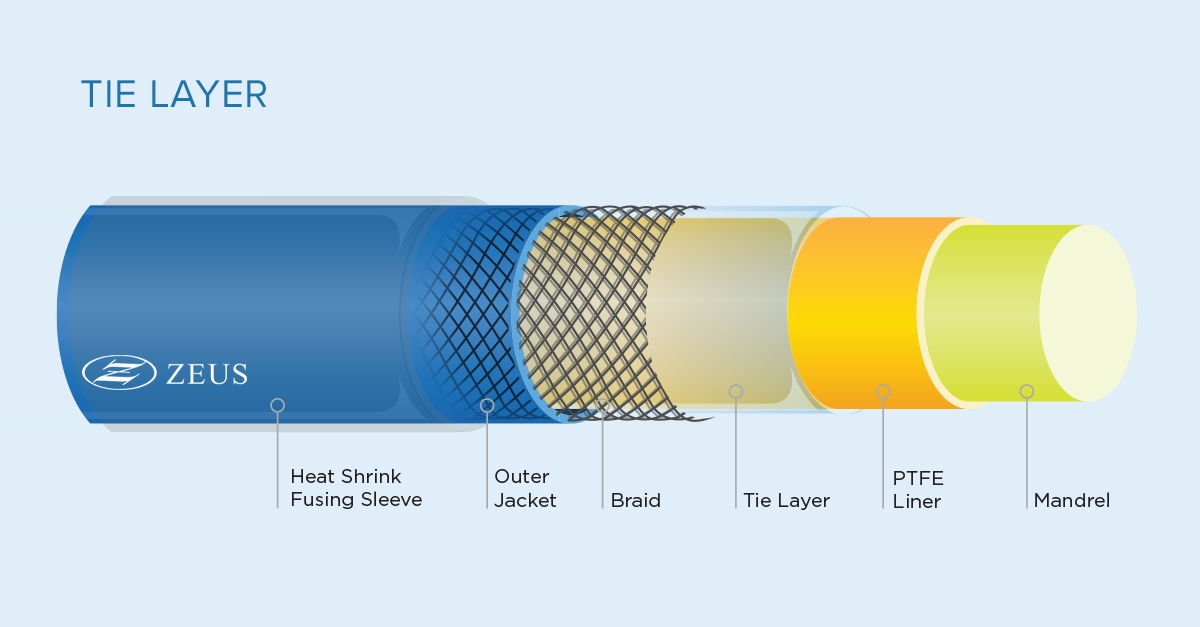Product engineers at catheter manufacturing companies will be only too aware of the problem of delamination – the separation of material layers within the catheter. Typically, delamination issues are not detected until final testing, after catheter assembly is complete, incurring significantly high scrap costs for manufacturers.
If devices fail in the field, the consequences may be even more serious – patient safety is at risk and the lengthy, costly logistical challenges of a product recall could ensue.
A recurring vulnerability
Through our long-standing relationships with key global players in catheter manufacturing, Zeus understood the urgent need for a solution to delamination. Our Global Medical Market team identified a recurring vulnerability across the industry – the separation of the etched PTFE liner from the jacket and braiding within the catheter. If we could reduce, and possibly even eliminate, the reliability of catheters could be transformed.
Developing the “Tie Layer”
The solution, according to the R&D team here at Zeus, lay in the design of an additional material layer between the inner etched PTFE liner and the outer jacket material of the catheter. This extra layer would deliver the crucial adhesion required to prevent delamination, ideally without increasing the outer diameter of the finished catheter.
After in-depth trialing, Zeus engineers achieved a design that would finally improve catheter reliability. They created an ultra-thin thermoplastic coating, which is applied to the PTFE liner before catheter construction. Designed specifically to adhere to the freshly etched PTFE liner surface,=Tie Layer is typically made from the same materials as the catheter jacket, creating a like-for-like bond between liner and jacket.
Testing shows the resulting catheters can display up to 2.5 times stronger bond strength than those without a Tie Layer. Furthermore, with coating dimensions as thin as 0.0025 mm (0.0001″), any impact to the overall catheter profile is minimal. This innovation is proving to significantly reduce delamination.
How the Tie Layer transforms catheter production
1. Improved patient safety – liner/jacket delamination in the catheter poses significant risk to patients through product failure.
2. Greater profitability – manufacturers can reduce expensive product recalls, scrap rates, and inspection costs. Increased product yield and throughput relieves pressure on the bottom line.
3. Creation of new design possibilities – with the issue of delamination under control, R&D and design engineers can focus on innovation when creating their next generation catheters.
4. Enhanced performance – having access to a variety of Tie Layer materials and varying durometers allows R&D engineers to customize flexibility or stiffness into their next design. This translates to improved trackability, deliverability, and overall performance.
The creation of the Tie Layer is just one example of our ongoing commitment and contribution to innovation within the medical device industry. The ultimate success of this new product development project was down to the close working relationships Zeus maintains with customers in the catheter manufacturing industry.
Thanks to an in-depth understanding of critical device design issues, we were able to pinpoint the problem and develop an appropriate solution; a solution that I have no doubt will revolutionize product design and safety for catheter manufacturers.

Author: Matt Allen, Senior Product Manager
For almost two decades, Matt has been involved in helping Zeus’ customers drive innovation and develop new and improved technologies for the medical industry.
Known for his solutions-based approach, Matt is a highly respected business leader and product management expert in the medical devices space. He is most celebrated for his deep knowledge of the cardiovascular, peripheral and neurovascular markets.
